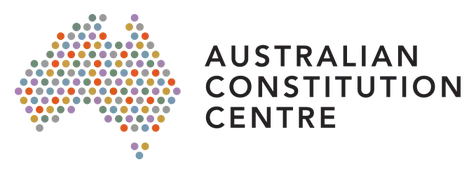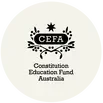The curriculum for the Australian Constitution Centre will be developed into further year based lesson plans on an ongoing basis and in consultation with teachers. We greatly value all teacher feedback and input. This can be provided through the Contact Us area of this website. Alternatively feedback can be provided to the High Court after a class Exhibition visit. We are also planning professional development days. If you are interested in our work we encourage you to get involved.
Some indicative year level based teaching and learning suggested lessons are provided below:
Year 5
Lesson 1 ACHASSK116
Objective: Investigate how people participate in groups and in their communities, to achieve shared goals under Australia’s democracy.
Resource: The Amalgamated Society of Engineers v Adelaide Steamship Company Limited and Ors (1920). Engineers Union succeeds in the High Court, expanding Federal power.
Lesson 2 ACHASSK118
Objective: Students know and understand how Aboriginal and Torres Strait Islander Peoples have achieved land rights (native title) and how this has influenced the development of Australia as a nation.
Resource: Mabo v Queensland (No 2) (1992). High Court overturns 200 years of common law.
Lesson 3 ACHASSI102
Objective: Students know and understand how to identify community issues and develop possible solutions and plans for action using decision making processes that might lead to Parliament enacting new legislation.
Resource: Parliaments in Schools: The Constitution Education Fund program
Lesson 4 ACHASSK116
Objective: Students know and understand representative democracy by examining the features of the voting processes in Australia and who is eligible to vote.
Resource: Roach v The Electoral Commissioner (2007). The right to vote survives incarceration
Lesson 5 ACHASSK118
Objective: Students know and understand how people with shared beliefs and values work together to achieve a fair and just civic goals. Through enacting mock trials.
Year 6
Lesson 1 ACHASSK134
Objective: To learn who key figures are in events that led to federation, Australia’s system of government and the values integral to a fair and just society.
Resource: Timeline
Resource: The writers of the Constitution.
Lesson 2 ACHASSK135
Objective: To learn how experiences of democracy and citizenship varied in different times and places, including in the story of parliamentary democracy and experiences in Asia.
Resource: Timeline.
Lesson 3 ACHASSK148
Objective: To identify individual and community responsibilities, as an Australian and as a global citizen, with an emphasis on sustainability.
Resource: The Commonwealth of Australia v Tasmania (1983). The Constitution Saves the Franklin River.
Lesson 4 ACHASSK144
Objective: To learn about the different levels of government in Australia and the roles and responsibilities of the people and institutions in it.
Resource: PDF: Levels of Government
Resource: PDF: separation of powers.
Lesson 5 ACHASSK143, ACHASSK146
Objective: To learn how laws are developed in Australia and how the High Court can invalidate Australian Parliament legislation.
Resource: Graham v Minister for Immigration (2017)
Resource: Australian Communist Party v The Commonwealth of Australia (1951)
Lesson 6 ACHASSK134
Objective: Students know and understand the key figures in the events and ideas that led to Australia’s Federation and the writing of the Constitution in the late 1800s.
Resource: Timeline.
Lesson 7 ACHASSK134
Objective: Students know and understand key elements of Australia’s system of law and government and their origin (Magna Carta; federalism; constitutional monarchy; the Westminster system and the separation of powers – legislature, executive, judiciary; the houses of parliament; how laws are made).
Resource: Timeline.
Lesson 8 ACHASSK135
Objective: How Aboriginal and Torres Strait Islander peoples have contributed to Australian national identity.
Resource: Mabo v Queensland (No 2) (1992) High Court overturns 200 years of common law.
Objective: Examine the 1967 referendum and the subsequent things that have happened since.
Resource: The Constitution Education Fund: 50th anniversary of the 1967 referendum
Lesson 9 ACHASSK143
Objective: Students know and understand how the separation of powers helps resolve contentious issues so that Australia moves forward as a nation.
Resource: Graham v Minister for Immigration (2017) to discuss the concept of global citizenship.
Resource: Separation of powers.
Lesson 10 ACHASSK146
Objective: Students know and understand how to use and evaluate a range of information to develop a point of view.
Resource: Parliaments in Schools: The Constitution Education Fund program
Lesson 11 ACHASSK134
Objective: Students research significant Australians who contributed to the Australian democracy as it was achieved at Federation.
Resource: Timeline from 1857 (e.g.: Intercolonial conferences, Henry Parkes, Samuel Griffith Catherine Spence, South Australia, and the suffragette movement giving women the vote).
Lesson 12 ACHASSK148
Objective: Students explore the meaning of dual citizenship for Members of Parliament under section 44 of the Australian Constitution and its implications for identity and belonging.
Resource: The Constitution Education Fund: citizenship
Resource: Nationhood.
Year 7
Lesson 1 ACHCK048
Objective: To explore the first three chapters of our Constitution which outline the separation of powers for the parliament (the legislature), the Government (the executive) and the Courts (the judiciary).
Resource: Principle 3: Separation of powers, Levels of Government
Resource: The Constitution Education Fund: Constitution.
Lesson 2 ACHCK048
Objective: To learn how the separation of powers seeks to prevent the excessive concentration of power.
Resource: Principle 3: Separation of powers, Levels of Government
Resource: The Constitution Education Fund Constitution.
Lesson 3 ACHCK049
Objective: To learn how the Australian Constitution can only be changed by the will of Australian Citizens who are eligible to vote.
Resource: Referendums CCF.
Objective: Students know and understand how referendums work and are the process for constitutional alteration. (Aboriginal and Torres Strait Islander Peoples and the Constitutional change through the successful Constitutional Alteration Act (Aboriginals) 1967.
Resource: The Constitution Education Fund: 50th anniversary of the 1967 referendum
Resource: Australian Electoral Commission (AEC) “Democracy Rules”
Lesson 4 ACHCK048
Objective: Students know and understand the sections of the Australian constitution relating to the composition of the Legislature (the Queen, represented by the Governor-General, and the Senate and the House of Representatives), Executive (the Queen, represented by the Governor-General, the Ministers), and the Judiciary (the High Court and other Federal Courts).
Resource: The Constitution Education Fund: Constitution
Resource: Separation of powers.
Lesson 5 ACHCK050
Objective: Students know and understand how Australia’s legal system aims to provide justice, including through the rule of law, presumption of innocence, burden of proof, right to a fair trial and the right to legal representation.
Resource: The rule of Law
Resource: Rights.
Year 8
Lesson 1 ACHCK062
Objective: Students know and understand how citizens can participate in Australia’s democracy, including the use of the electoral system, contact with their elected representatives, use of lobby groups and direct action.
Resource: The Amalgamated Society of Engineers v Adelaide Steamship Company Limited and Ors (1920). Engineers Union succeeds in the High Court, expanding Federal power
Resource: The Commonwealth of Australia v Tasmania (1983).
Lessons 2 ACHCK061
Objective: Examining examples where citizens have taken direct action such as organising a public demonstration or social media campaign.
Resource: The Commonwealth of Australia v Tasmania (1983)
Resource: Australian Communist Party v The Commonwealth of Australia (1951).
Lesson 3ACHCK063
Objective: Respond to exercises on government decision making, voting, leadership and the making of laws.
Resource: The Constitution Education Fund: Parliaments in Schools
Activity: debate whether voting should remain compulsory in Australia.
Resource: The Constitution Education Fund: voting is critical to our democracy, The Constitution Education Fund: Voting: the UK v Australia, The Constitution Education Fund: Is electronic voting a good idea?
Resource: The Constitution Education Fund: CCF voting.
Year 9
Lesson 1 ACHCK079
Objective: Identify how and why individuals and groups, including religious groups, participate in and contribute to civic life, through their right to freedom of association under the Australian Constitution.
Resource: Australian Communist Party v The Commonwealth of Australia (1951). The Government overreached when it banned the Communist Party.
Lesson 2 ACHCK103
Objective: Students know and understand how policy is developed and implemented and the role of the public service in Australia, including the role of Prime minister and Cabinet in proposing policy and the role of government in debating it.
Resource: Separation of powers.
Lesson 3 ACHCK075, ACHCK103
Objective: Students know and understand the role of the opposition in debating policy proposed by the Executive and the role of the Parliament in authorising Government to spend money and scrutinising the administrative actions of the government.
Resource: The Constitution Education Fund: Parliaments in Schools
Resource: The Constitution Education Fund: The Constitutional process for government spending
Lesson 4 ACHCK077
Objective: Students know and Understand how court judgements impact on the development of law (for example, the role of precedents).
Resource: The role of the High Court
Resource: The Constitution Education Fund: CCF the Role of the High Court in the Australian Democracy.
Lesson 5 ACHCK087
Objective: Demonstrate skills in responding to civics questions as individuals and in teams such as taking responsibility for respectful interactions with others. Use democratic processes to reach consensus on a course of action relating to a civics or citizenship issue and plan for that action. Set up a School Parliament and hold elections, run political party campaigns using public debate, media releases and a range of other strategies and develop legislation.
Resource: How to set up a School Parliament
Resource: encourage students to participate in Constitutional Conventions.
Year 10
Lesson 1 ACHCK090
Objective: Students know and understand the roles and responsibilities Australia’s government plays at a global level for the provision of foreign aid, peacekeeping, participation in international organisations, the United Nations, the environment and sustainability, Human Rights, World Heritage and other international functions.
Resource: The Commonwealth of Australia v Tasmania (1983). The Constitution Saves the Franklin River, Nationhood, Federalism
Resource: The Constitution Education Fund: Does international law fit within our constitutional democracy today?
Lesson 2 ACHCK092
Objective: Students know and understand how the Mabo decision is an example of the High Court function in interpreting and applying Australian law.
Resource: Mabo v Queensland (No 2) (1992). High Court overturns 200 years of common law.
Lesson 3 ACHCK093
Objective: Students know and understand some of the international agreements Australia has ratified including how each one shapes government policies and laws, and exploring whether it is Constitutional, through section 51 external affairs power of the Australian Constitution.
Resource: The Commonwealth of Australia v Tasmania (1983). The Constitution Saves the Franklin River
Resource: Nationhood
Resource: Federalism.
Lesson 4 ACHCK092
Objective: Identify contemporary Constitutional topics and issues that may involve dissent, uncertainty or be open to interpretation and debate.
Resource: The Constitution Education Fund: Do we have a constitutional right to protest? – two Justices dissented on this recent case.



